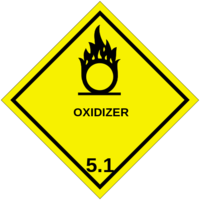-
New micro helicopters for search and rescue missions
New micro helicopters have a diameter of about fifty centimeters, weigh only 1,500 grams; they do not rquire GPS or remote control to navigate; they are designed to maneuver in tight or even enclosed spaces, and to detect and fly around any obstacle; possible uses could include protection or rescue missions, and they are ideal for flying over disaster areas and giving a picture of the situation from the air or locating victims
-
-
Harris deploys public safety communications system in Virginia
Harris Corporation has received a $10 million contract from Pittsylvania County, Virginia, to deploy a public safety digital communications system based on P25 Phase 2 standards
-
-
1962 disaster leads to stricter hazmat transportation regulations

Federal transportation law requires all vehicles carrying hazardous materials to display information placards, diamond-shaped, color-coded signs with numbers and symbols posted at various points on the truck; the law is the result of a 1962 Connecticut accident, in which four fire fighters died because they were not aware of the hazardous material a truck, which was on fire, was carrying
-
-
Review of HTV-2 second test flight concluded

The goal of the Pentagon’s Conventional Prompt Global Strike initiatives is for the U.S. military to have the capability to reach anywhere in the world in less than one hour; a key element of the project is the is Hypersonic Technology Vehicle (HTV-2), which can reach speeds up to twenty times the speed of sound; during an 11 August 2011 flight test, the HTV-2 developed what DARPA describes as “flight anomalies,” which an engineering review board has examined
-
-
Wisconsin county has a new LMR system
In Rock County, Wisconsin, firefighters have been required manually to change radio channels as they moved from North to South because of two different frequencies in the region; Raytheon is helping to combine three disparate communications systems in the country into one; the result will be more efficient – and interoperable – first response communication system
-
-
Efficiency of multi-hop wireless networks boosted
Multi-hop wireless networks can provide data access for large and unconventional spaces, but they have long faced significant limits on the amount of data they can transmit; now researchers have developed a more efficient data transmission approach that can boost the amount of data the networks can transmit by 20 to 80 percent
-
-
San Francisco earthquake planners developing pet-disaster response

San Francisco is preparing for the Big One in more ways than one: the latest addition to the city’s disaster preparedness plans is a legion of pet disaster responders, trained by city officials to rescue pet dogs, cats, rodents, birds, and reptiles in the event of a disaster, and transport them to one of 125 temporary shelters
-
-
Baltimore police to videotape confessions
More and more police departments are videotaping suspects’ confessions, and presenting these recordings as evidence during legal proceedings; the cost of recording equipment has declined, but all these recordings must be catalogued and stored, and must be accessible upon request, adding to the total cost of system ownership and operation
-
-
New sensor to enable military operations in GPS-denied areas
Many U.S. military systems, such as missiles, rely on the Global Positioning System (GPS) to provide accurate position, orientation, and time information while in flight; a DARPA project seeks an atomic inertial sensor to measure orientation in GPS-denied environments
-
-
More efficient bioterrorism response plan
In the event of a bioterror attack on a building (think: the 2011 anthrax attack on the offices of two Democratic Senators, Tom Daschle of South Dakota and Patrick Leahy of Vermont), the current approach to decontamination is to clean up the building until no pathogens can be detected; researchers suggest, however, that whether or not pathogens are found depends greatly upon how extensively the buildings are tested
-
-
Identifying ammunition, gun used to commit a crime
New, Raman spectroscopy-based gun-shot residue (GSR) analysis technique would make it possible for forensic investigators to match minute amounts of GSR to the exact type of ammunition, and the caliber of the gun, used to commit a crime
-
-
The technology behind the Zimmerman arrest video
Van Nuys, California-based Forensic Protection was asked by ABC News to clarify the grainy video showing George Zimmerman being brought to the Sanford Police Department headquarters; the video clarification work was so good, other media outlets used it (even if they attributed the technical work to ABC News); Forensic Protection insists that its client not disclose what it is that they are seeking or looking for in the clarification process: this allows the results of the clarification to stand on their merit
-
-
DARPA offers $2 million in prizes for Robotic Challenge winners
DARPA is seeking hardware, software, modeling, and gaming developers to link with emergency response and science communities to design robots capable of supervised autonomous response to simulated disaster
-
-
DHS cuts grants to states, emphasizes maintenance

Over the past few years, DHS has been cutting funding for grants to state and emergency response agencies; the billions of dollars given to states after 2011 have been used to buy many pieces of first-response and law-enforcement equipment, and DHS now emphasizes the maintenance of that equipment
-
-
Advanced technologies shed more light on the killing of Trayvon Martin
Since only two people know what happened in the confrontation between George Zimmerman and Trayvon Martin, and since one of them is dead, investigators must rely on circumstantial evidence — and on advanced technology; two such technologies — voice biometrics and redigitized imaging — help shed more light on the fateful February night
-
More headlines
The long view
Are We Ready for a ‘DeepSeek for Bioweapons’?
Anthropic’s Claude 4 is a warning sign: AI that can help build bioweapons is coming, and could be widely available soon. Steven Adler writes that we need to be prepared for the consequences: “like a freely downloadable ‘DeepSeek for bioweapons,’ available across the internet, loadable to the computer of any amateur scientist who wishes to cause mass harm. With Anthropic’s Claude Opus 4 having finally triggered this level of safety risk, the clock is now ticking.”
“The Federal Government Is Gone”: Under Trump, the Fight Against Extremist Violence Is Left Up to the States
As President Donald Trump guts the main federal office dedicated to preventing terrorism, states say they’re left to take the lead in spotlighting threats. Some state efforts are robust, others are fledgling, and yet other states are still formalizing strategies for addressing extremism. With the federal government largely retreating from focusing on extremist dangers, prevention advocates say the threat of violent extremism is likely to increase.
Luigi Mangione and the Making of a ‘Terrorist’
Discretion is crucial to the American tradition of criminal law, Jacob Ware and Ania Zolyniak write, noting that “lawmakers enact broader statutes to empower prosecutors to pursue justice while entrusting that they will stay within the confines of their authority and screen out the inevitable “absurd” cases that may arise.” Discretion is also vital to maintaining the legitimacy of the legal system. In the prosecution’s case against Luigi Mangione, they charge, “That discretion was abused.”
Autonomous Weapon Systems: No Human-in-the-Loop Required, and Other Myths Dispelled
“The United States has a strong policy on autonomy in weapon systems that simultaneously enables their development and deployment and ensures they could be used in an effective manner, meaning the systems work as intended, with the same minimal risk of accidents or errors that all weapon systems have,” Michael Horowitz writes.
Ukraine Drone Strikes on Russian Airbase Reveal Any Country Is Vulnerable to the Same Kind of Attack
Air defense systems are built on the assumption that threats come from above and from beyond national borders. But Ukraine’s coordinated drone strike on 1 June on five airbases deep inside Russian territory exposed what happens when states are attacked from below and from within. In low-level airspace, visibility drops, responsibility fragments, and detection tools lose their edge. Drones arrive unannounced, response times lag, coordination breaks.
Shots to the Dome—Why We Can’t Model US Missile Defense on Israel’s “Iron Dome”
Starting an arms race where the costs are stacked against you at a time when debt-to-GDP is approaching an all-time high seems reckless. All in all, the idea behind Golden Dome is still quite undercooked.
